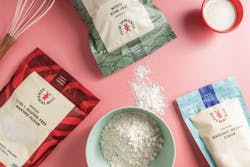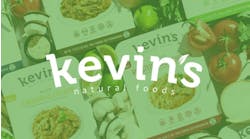The name of Dan Kurzrock’s company is Upcycled Foods Inc. (upcycledfoods.com), so it’s no surprise that Kurzrock is an advocate of the Upcycled Certified designation, which is administered by the Upcycled Food Assn. (UFA) (www.upcycledfood.org). He’s confident that the marketing value of earning the certification is worth the effort.
“You need a way to communicate the value of the product to an end customer,” explains Kurzrock, whose company converts spent grains from breweries into ReGrained Supergrain+ grain powder. “Having third-party certifications is a way to show that you’re for real. They show there’s nothing to hide, and that this is not just a marketing push. It’s a core part of a business model that seeks to make the world a better place.”
Upcycled Foods is one of 92 companies that have earned the Upcycled Certified designation for one or more products since the designation was launched in 2021, says Mariel Nunley, certification manager of UFA. A total of 491 products now have the designation. About one third of them are ingredients used by food processors and the rest are retail products.
Nunley has statistics that back up Kurzrock’s belief in the value of the designation. “We have a couple stats that speak to the value of certification,” she reports. “One is a study that showed that more than 50% of consumers had an increased intent to buy Upcycled Certified foods when the logo was on packaging. Another data point we have is that between 2021 and 2022, Upcycled Certified products saw about an average of a 21% sales increase in that time. So we do believe that the certification is resonating with consumers.”
The basics of certification
Getting Upcycled certified involves documenting that a product is taking some food input that otherwise would have been wasted and using it in a product designed for human consumption. Common examples are flour made from the byproducts of tofu production; juice made from fruit that was considered unsuitable for retail sale; and tea made from cascara, the dried skin of coffee cherries.
“We would consider a waste stream to also be potentially different destinations,” Nunley notes. “So landfill is the most obvious example of an ingredient that was previously put into the trash. But we would also consider destinations like animal feed, a composting facility, anaerobic digestion, incineration.
“Or even if a fresh fruit or vegetable is left unharvested on a field because there's no market or there's too many cosmetic imperfections for that produce, we would consider all of those to be waste streams.”
The Upcycled Certification can be applied to ingredients and retail products, though the standards are different. An ingredient must contain 95% upcycled input by weight, excluding added water. A retail product must contain a minimum of 10% upcycled input.
For example, Just Date Organic Date Sugar (enjoyjustdate.com) is made from imperfect dates that are too “ugly” for normal retail sale, and there are no other ingredients. The product, thus, is 100% upcycled and is classified as an Upcycled Ingredient.
On the retail product side, Kazoo Snacks’ tortilla chips contain 40% corn germ that is repurposed from the corn starch manufacturing process; thus, that product easily exceeds the 10% threshold for an Upcycled Certified retail product.
The Upcycled Food Assn. does not do the certification itself. Instead, it partners with an organization called Where Food Comes From (www.wherefoodcomesfrom.com) for the certification. This organization also handles non-GMO certification, gluten-free certification, and several others. Nunley says having Where Food Comes From handle the certification ensures the credibility and transparency of the process and removes any potential bias.
The certification process is fairly rapid, at least for a company that has its documentation in order. For example, Madeline Vidibor, director of operations at Just Date, says it took under six weeks to get the Just Date Organic Date Sugar certified. Kurzrock says getting certification for ReGrained Supergrain+ took “definitely inside of a quarter.”
The process is repeated annually to ensure products continue to meet the standards. And if something important changes in a product’s supply chain between audits, the company is required to report that so the association can make sure the product is still compliant.
Natural synergies
There is a natural synergy between Upcycled Certified ingredient makers and companies seeking certification for their retail products.
“Our Organic Date Sugar is a featured ingredient in baking mixes, nut butters, snacks and confections,” notes Vidibor. “Since this is certified as an Upcycled Ingredient, manufacturers and brands looking to achieve certification themselves can do so easily by incorporating our product.”
That idea is backed up by Caroline Cotto, co-founder and COO of Renewal Mill (www.renewalmill.com), which produces certified ingredients such as Oat Milk Flour as well as certified retail products, such as Snickerdoodle Cookie Mix. “Our ingredient customers very much value the certification because if they use our certified ingredients in their formulations, they too can get their products Upcycled Certified.”
In fact, UFA encourages its members to work together, Nunley says. When the association learns of a company seeking to create an upcycled product and needs a specific ingredient, they try to make the connection.
The website of Kurzrock’s company, Upcycled Foods Inc., reveals some of these connections: The company partnered with Puratos to make baking ingredients incorporating Regrained upcycled flour, and it paired with California Cereal Products create upcycled grain flakes.
How get and stay certified
The certification process begins with “scoping,” which means the company seeking certification discusses their situation with Where Food Comes From. The scoping process involves determining how many products a company wants to certify, the number of facilities involved in producing those products, the documentation that will be required and other relevant topics.
Once the scoping is done, the company signs a licensing agreement and begins preparing new packaging that includes the Upcycled Certified logo.
For example, for Upcycled Foods to certify its Regrained Supergrain product, it provided documentation to show that the breweries had previously been sending the spent grain to enterprises using it for animal feed.
“One of the key areas of importance for this certification, as we see it, is to provide transparency and ensure authenticity and the veracity of the claim that this is a product that, without this innovation, would've not gone to human consumption,” Kurzrock says. “That is critical to enabling the consumers to understand, ‘Hey, this is what upcycling means.’ It means something. It's not a diluted, greenwashed term.”
Once Where Food Comes From is satisfied that the product in question is genuinely upcycled, UFA lists the product on its website and provides the company with a marketing toolkit that includes talking points, best practices for conversations with retailers and consumers, press release templates and other resources that help the company maximize the return on its Upcycled Certified investment.
The cost
Speaking of investment, the cost of certification varies depending on how many products a company seeks to certify. The first fee is a $695 enrollment fee, which is waived for companies that are members of the association. Then there is a licensing fee payable to the association that ranges from $149 to $219 per product, depending on the number of products.
Then Where Food Comes From charges its own set of fees: a one-time New Participant Fee of $250; a Review Fee of $1,250, which covers the first five products; and a Facility Review Fee of $500 for each facility producing a company’s products.
The bottom line cost for certifying five products for a company with one facility that is not a member of the association is $3,790. Those fees are charged annually, with the exception of the New Participant Fee.
Is it worth it? Participants say yes, and for a variety of reasons.
“We find the Upcycled Certification to be very helpful,” Cotto says. “It’s a great way to protect against greenwashing because the legal teams of large sales partners like Kroger and Whole Foods look toward these types of third-party audits as a way to verify sustainability claims.
“Additionally, it allows for a lot of joint marketing and joint merchandising opportunities with other upcycled brands because it gives customers a single image to look for and rally around,” she continues. “Retailers are doing things like curating upcycled collections or upcycled end caps and using the certification as a way to identify the high brands should be included.”
Vidibor says the Upcycled Certification gives interested consumers a window into the processes behind food manufacturing.
“Food waste is a serious issue in our industry, and consumers have little visibility into the supply chain and manufacturing process,” she says. “The Upcycled Certified mark signifies a verified supply and positive environmental impact. Increasing the number of visibly certified products helps raise awareness of upcycling as a method to mitigate climate change, which we feel is worth the investment.”




